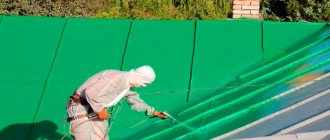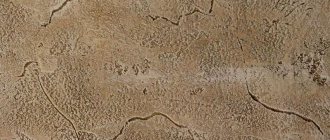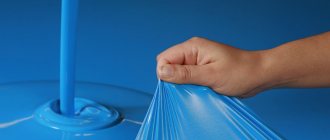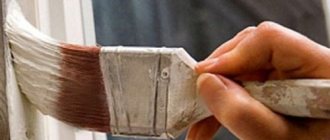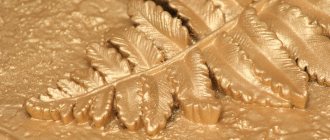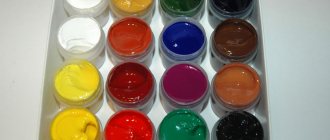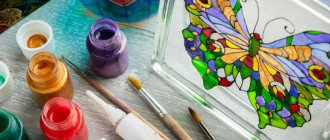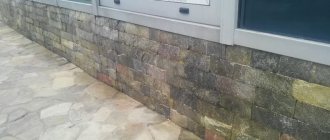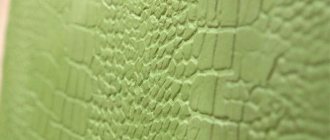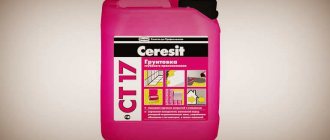A large assortment of paint and varnish coatings allows consumers to choose the most optimal option for themselves. Among the abundance of offers from manufacturers, hammer paint stands out. It gained popularity due to its unique texture and relief, which in external parameters resembles real hand-chasing.
| Category | Name | Price | Briefly about the main thing |
| The best hammer paint for metal | Hammerite | 2 l – 2000 rub. | Composition 3 in 1 – primer, rust converter, coloring enamel. Dries quickly, the smell is minimal. Very high quality. |
| Tex RustStop 3 in 1 | 0.5 l – 400 rub. | Suitable for steel and cast iron surfaces with corrosion residues. Converts rust well. For a dense color you need 2-3 layers. | |
| The best hammer paint for cars | Kudo KU | 0.52 l – 230 rub. | Universal enamel 3 in 1. Contains anti-corrosion components and silicones. It can be applied to rust, but it is better to clean it first. |
| BOSNY Hammer | 0.4 l – 200 rub. | Hammer enamel based on artificial resins. It creates an original relief on the surface, protects well from corrosion, and does not snap off. | |
| The best hammer paint for radiators | Certa-Plast | 0.8 l – 600 rub. | Suitable for cast iron and steel radiators. No preliminary primer is required - it converts rust well. You need 2-3 layers. |
| Mister Hammer | 1 l – 650 rub. | Colored heat-resistant enamel with diamond shine or crumbs. The smooth, semi-matte coating does not fade or fade over time. | |
| The best hammer paint for gates and metal doors | Molotex | 800 ml – 5550 rub. | Forging paint 3 in 1. High coefficient of anti-corrosion protection. Contains silicone resins and metal pigments. |
What is hammer paint
The material got its name for its relief texture, reminiscent of embossing. It is also called blacksmith paint (enamel). Available in cans and jars.
Composition characteristics
Basic set of components:
- Nitrocellulose, alkyd, epoxy or acrylic enamel. This is the base of the paint.
- Aluminum flakes and defatted powder (non-floating), glass chips, zinc phosphate, silicon-based organic compounds: silicone oil, petroleum jelly, rubber. This is a filler that acts as a pattern-former.
- Mineral or organic pigment to impart color.
- Solvents – ketone and paraffin compounds.
The aluminum filler gives the coating strength and, together with organic additives, changes the surface tension. This leads to the formation of a hammer effect due to the curvature of the outer film.
To maintain its integrity, it is necessary to ensure that the aluminum stays closer to the substrate (does not float up). For this purpose, it is degreased.
In addition to the listed components, others may be present in the composition. They do not affect the characteristics and are mainly used by manufacturers to promote products on the market.
Scope of application
Hammer enamel was created for harsh operating conditions. It is painted with:
- Production and laboratory equipment exposed to chemical and mechanical factors, vibration, temperature and humidity changes.
- Industrial structures located on the street.
- Means of transport.
The non-standard appearance led to the use of hammer enamels “for other purposes” – as a decorative coating. It is used to paint safes, artistic forging items and other products with high aesthetic requirements, benches, fences, gates and wickets.
Forge enamel goes well not only with metals. It covers wood, ceramics, plastic, etc.
Industrial structures located on the street are painted with hammer enamel.
Types of hammer paint
The following types of coatings are produced:
- powder;
- liquid.
The second option is the most common. Alkyd paints are most often purchased.
The following domestic brands have confirmed their quality through many years of use:
- NTs-221. Relatively inexpensive nitrocellulose-based enamel. It is not moisture resistant and is intended for interior use only.
- ML-165. Alkyd-styrene based coating. It is characterized by heat resistance (up to +130°C) and high adhesive strength. Suitable for outdoor use, can be applied to rust (contains converters).
- EP-1323ME. Epoxy based composition. It also has high adhesion, heat and moisture resistance. Suitable for all types of work.
Among imported ones, Hammerite alkyd paint has the greatest durability. The material can be applied to rusty surfaces. Its disadvantage is its high cost.
Advantages and disadvantages
Hammer enamel for metal has the following advantages:
- Resistant to extreme temperatures and sudden changes. The most heat-resistant versions can withstand heating up to +300°C.
- Anti-corrosion effect.
- Increased strength.
- Ability to neutralize rust.
- Short drying time. Aerosol paint has the lowest indicator.
- Moisture resistance.
- Durability. The paint lasts 8 years, color brightness lasts 3 years.
- No harmful fumes. The material is suitable for use in residential premises.
- Aesthetic qualities.
- Color variety.
- Dirt- and water-repellent effect.
- Low requirements for the evenness of the painted surface. The relief texture of the paint smoothes out defects.
- Maintainability. If there is damage, the product does not need to be completely repainted. The coating is restored only on the damaged area, after which the defect becomes invisible.
- Vibration resistant.
- Good hiding power (the ability to paint over the color of the base).
- Resistant to weather conditions, oil, weak alkalis and acids.
Flaws:
- Lack of plasticity. Microcracks may appear in the corners, allowing moisture to pass through to the metal.
- Increased consumption. The average is 100 g/m2.
- High price.
- Difficulty with removal. The material is difficult to peel and solvents.
- Possibility of rust spreading from unpainted areas to enamel.
Moisture resistance is one of the advantages of paint.
Color palette
The first versions of blacksmith's enamel had only black, white or gray colors, since they were used in industry for purely utilitarian purposes. Later, when the decorative qualities of the material were appreciated and the demand for it increased, stamps with different pigments began to be produced. The following options are available:
- golden;
- copper and bronze;
- silver;
- blue, blue, violet;
- green, khaki;
- red, brown, chocolate.
The best manufacturers
In Russia, the following companies and enterprises are engaged in the production of hammer effect paints:
- "TEX" (St. Petersburg).
- Group . He is the owner of the KUDO trademark.
- "NPP Rogneda". Owner of TM Dali.
- "KrasKo" (Moscow). They produce Molotex enamels.
- . Owner .
- . Manufactures products under .
- TH "LAKRA". Launches Parade Z1 hammer enamel.
The most popular among foreign ones are:
- Hammerite (UK).
- Permo (Finland).
- Alpina (Germany).
- Dufa (Germany).
Hammerite is a popular foreign brand of hammer paint.
Types and composition
Hammer effect paint is something many people wonder about; if you look at the layer of the composition after drying, you can see not a smooth base, but covered with “shagreen”, reminiscent of a pattern of work with a blacksmith’s hammer.
The effect is achieved by adding the following substances:
- Alkyd resin;
- Epoxy resin;
- Aluminum powder or flakes;
- Silicone oils and resins;
- Small glass particles.
There are several hammer paint solutions available for sale; they differ in their constituent substances, so you should understand the features of each in order to choose the right option for the working conditions:
- MP165, made from alkyd resin and styrene, can withstand high temperatures up to +130 degrees, has a good degree of adhesion to various materials;
- EP123 ME, epoxy type, can be used as primer and paint. This material is often chosen for processing gates, fences, and elements in vehicles. Can be applied to rusty areas;
- NTs221 can be classified as a composition that serves for decorative purposes; its protective functions are not high, but the cost is lower than others. Do not paint over corrosive areas; suitable for interior and exterior use;
- Hammiright tops the rating of hammer compounds, it stands out for its high quality, it creates reliable protection against precipitation, but the cost of the product is high.
Hammer solutions are also produced by other brands; you should carefully study the technical characteristics of the product before purchasing.
Hammiright tops the rating of hammer compounds and stands out for its high quality.
What affects operation
While aluminum filler is added to other paints to impart gas and water resistance, heat resistance and other properties, in blacksmith paint it primarily performs a decorative function. Performance characteristics depend only on the enamel, which acts as a base.
Powder hammer paints
Powder paint is applied with a spray gun. At the same time, a static charge is imparted to it, while the product to be painted is connected to the pole of a direct current source. As a result, particles are held on the surface due to electrical attraction.
Next, the product enters a special oven where the coating is sintered.
This type of paint is characterized by increased resistance to mechanical stress. But with prolonged use in the open air, its structure is destroyed under the influence of ultraviolet radiation. As a result of the photochemical activity of the pigment, areas of erosion are formed around it. This process is called chalking. A sign is a change in the gloss of the coating. Damaged areas are chipped under mechanical stress, which leads to loss of strength and protective properties of the coating.
Liquid enamel
The performance characteristics of liquid paint are influenced by the following factors:
- Condition of the base. The inscription in the characteristic “enamel against rust” is interpreted by some as a lack of requirements for surface preparation. Preliminary removal of loose oxides will greatly extend the service life of the coating and increase adhesion strength. The material does not adhere well to smooth surfaces. It is sanded before painting.
- No greasy stains on the surface to be painted. This also has a positive effect on grip strength. Particular attention is paid to treating new products with a degreaser: they are often coated with factory lubricant.
- Primer. It is allowed to apply enamel directly to a metal surface. But pre-treatment with a primer will greatly improve its performance characteristics.
Color palette
Initially, the hammer composition was used only for processing tools, and only a gray solution was produced. Nowadays, the demand for paint has increased due to its good properties, and manufacturers offer a wide palette of shades. You can find brown, black, white, green, red, and more, so finding the right type should be easy.
For a small amount of work, you can use spray cans, which are convenient to take with you.
Any shade will have a shiny finish; the textured layer makes the paint look attractive; there are matte types.
Nowadays, the demand for paint has increased due to its good properties, and manufacturers offer a wide palette of shades.
Drying time
Information about how long the paint takes to dry is given in the instructions for use. On average, this takes 2 hours, after which the coating ceases to be sticky. But the enamel gains maximum strength after 2-3 days.
After painting the car, it is recommended to refrain from operating it during this time.
The influence of these factors depends on the manufacturer. Thus, Dali enamel from NPP Rogneda can be applied to stainless steel and non-ferrous metals without a primer. Hammerite products do not hold up well under these conditions.
Emerging problems
Lack of experience working with this paint often leads to a number of problems. Some people complain about the appearance of rust spots after painting. This can happen when the master doing the work tries to save on material. This is also noticed if low-quality products were purchased.
The result of haste is an uneven coating with small grooves and protrusions. This often happens when the recommended drying time between coats is not maintained. Peeling is the result of a poorly cleaned surface and, as a result, poor adhesion.
The result of haste is an uneven coating with small grooves and protrusions.
Hammerite products are highly targeted formulations that maintain a balance of components. The above shortcomings are only an indicator of haste and carelessness. And most importantly, buy only high-quality and certified goods in specialized stores, from time-tested sellers.
How to prepare a surface for painting
Before applying hammer paint to metal, it is subjected to the following types of processing:
- Use a brush with metal bristles or an abrasive tool to remove loose rust, burnt marks, scale, and peeling old paint. There is no need to completely remove the finish.
- If the surface is smooth, it is roughened using an abrasive tool: sandpaper, a drill with a special attachment, or a grinder with a grinding disc.
- Treat the product with a degreaser, for example white spirit, solvent (petroleum solvent) or “No. 646”. Then - acetone. You can wash it with washing powder, then rinse with clean water and dry. The absence of greasy stains is checked by applying a napkin or filter paper to the surface: there should be no traces on them.
The remaining old paint is tested for compatibility: enamel is applied to a small area and after a few hours the coating is examined for defects and adhesion. If the result is unsatisfactory, the previous finish is completely removed.
Before painting, the surface must be treated with a brush with metal bristles.
Flaws
The previously mentioned high adhesion can also be a disadvantage of such paint, since it is very difficult to clean off the metal if necessary. In addition, the disadvantage of the material is its relative high cost compared to other types of paint. However, the surfaces that are painted with this composition are usually small in size, so it will not be possible to incur serious costs.
Important! A low price should under no circumstances be a reason to purchase paint, since there are quite a lot of counterfeits on the market.
Technology of painting metal with hammer paint
There are several ways to apply enamel. The choice depends on the surface configuration and its area. In each case, you need to know how to paint correctly, otherwise the coating will be short-lived.
Using a brush
This method provides the most pronounced hammer effect. Paint with a brush:
- Small areas.
- Small elements with complex shapes belonging to large products.
- Furniture, frames and other items with high aesthetic requirements.
It is recommended to place the product horizontally. Thus, the metal door will have to be removed from its hinges. If this is not possible, use a quick-drying version of enamel.
Use a brush with natural bristles. Synthetic enamel is corroded by the solvents contained in the enamel.
The number of layers depends on the orientation of the surface:
- horizontal – 2;
- vertical – 3.
It is necessary to make sure that there are no untreated areas left on the product. Otherwise, any rust on them will spread to the paint.
Apply undiluted enamel with a brush.
Construction roller
This tool can be used to paint large, flat surfaces, such as a gate or cabinet wall. Use a short-haired tool made of the following materials:
- velor;
- fur.
Foam rubber is not suitable for the same reason as a synthetic brush: the solvents included in the paint corrode the polymers.
The enamel is applied in 2-3 layers. For the first, it is diluted with a solvent recommended by the manufacturer (1/9 of the paint volume). For alkyd mixtures, xylene and solvent are used in this capacity in most cases.
Small parts of complex configuration are pre-treated with a brush.
Use a roller to paint large, flat surfaces.
Aerosol spray
Use a spray can to paint:
- small items, such as artistic forging items;
- chips and other damage.
In the second case, you should first make sure that the paint shade matches the base coating.
Follow the rules:
- The sprayer is held at a distance of 15-20 cm from the surface to be painted.
- Shake periodically.
- Apply 3-4 thin layers. After the first, there is a pause of 3 minutes, then 20.
Pneumatic spray gun
This method is used for painting large surfaces, incl. relief. Skills in working with a spray gun and the ability to set it up correctly are required.
Follow the rules:
- The enamel is diluted with a solvent (1/7-1/8 of the paint volume). It is advisable to ensure the viscosity recommended by the manufacturer by monitoring it with a viscometer.
- Painting is done in 2-3 layers, the first one is made as thin as possible.
- Provide temperature within +18…+22°С.
Recommended settings:
- Pressure – 2.5-3.5 atm.
- Nozzle diameter – 3-4 mm.
- Spray cone angle – 65°.
The spraying method is characterized by the greatest losses - up to 50%.
Spray
This equipment is also designed for processing large flat and embossed surfaces. It carries out airless spraying of paint. The master must have the appropriate skills and know the required parameters to properly configure the spray gun. The application technology repeats the actions with a spray gun.
The spray gun carries out airless spraying of paint.
Advantages
The main advantages of this paint include:
- Apply directly to metal without pre-treatment or priming.
- It has high thermal stability and coating reliability.
- It tolerates moisture well, so it is often used outdoors.
- The high density of the colorant texture instantly hides any defects, efficiently filling all surface irregularities.
- UV resistance allows you not to fade in the sun, maintaining its original qualities for a long time.
- There are many application methods, so even a beginner can easily paint the desired surface.
- The wide range of uses of this paint is not limited only to metal products; it is also used for processing structures made of wood and plasterboard.
- Painted products are easy to clean, including with the use of aggressive surfactants.
Instructions for painting some surfaces
When applying enamel with your own hands, you must avoid untreated areas. It is useful to consider the procedure using the example of the most complex and massive structures.
Painting metal gates
It is recommended to remove the sashes and place them on stands made of bars. Then proceed like this:
- Use an abrasive tool or a wire brush to remove any loose old paint. The rest needs to be scraped together. If the coating does not fall off, then it can be left.
- Treat the sash with solvent or a similar degreaser, then with acetone.
- Cover the surface with a primer. Due to the high adhesive force, hammer enamel holds well even without this, but in the case of gates and doors, it is better not to ignore this stage.
- Dilute the paint with a solvent in the proportion corresponding to the selected tool (roller or spray gun).
- Apply the composition with a brush to the corners, hinges and edges of the product. If there are eyes for a padlock, they are also treated.
- Using a suitable tool, apply the enamel to the main surface. After drying, the product is repainted 1 or 2 times.
The last layer is made thick so that there are no drips on the gate.
Car coverage
Painting a vehicle has its own characteristics. If the rules are followed, a textured “alligator skin” pattern is achieved. The recommendations are as follows:
- No primer is used. Instead, the surface is carefully prepared and defects are filled with putty. After drying, it is sanded.
- The paint is applied in 2 layers with a break between them of 30 minutes.
- It takes 7 hours to dry completely.
- After 3 days they begin to operate the vehicle.
In the absence of experience, it is not recommended to dilute the enamel; it is better to use a ready-made composition of the required consistency. Knowledgeable craftsmen use solvents:
- For steel products – Rustbeater no1.
- For non-ferrous metals – Special Metals Primer.
By correctly using the solvent, a more pronounced decorative effect is achieved.
The diameter of the spray gun nozzle is 4 mm. The VZ-246 viscometer is suitable for determining the viscosity of enamel. The preferred tools are a roller or brush. They create a more pronounced relief and an attractive metallic sheen.
Painting can be done in the garage. For stable operation of the spray gun, the household compressor should be equipped with a 200 liter receiver.
When painting a car, the paint is applied in 2 layers with a break between them of 30 minutes.
Area of use
- Forged products, decorative items made of cast iron.
- Metal doors, fencing, fences, gates.
- Cars and mechanisms – car parts, electrical panels, etc.
- Steel structures – such as weather vanes, pipes, beams, support structures, fastenings.
- Furniture – cabinets, safes, benches, etc.
- Decorative items - frames, fittings, artistic forging, equipment and much more.
- Production equipment, specialized devices, racks, shelves.
Materials: can be painted on wood, metal, glass, tiles, plastic.
Important! Hammer painting involves applying the mixture to a horizontal surface. Therefore, before painting a metal door, remove it from its hinges and lay it flat. Otherwise, the paint may form smudges. If this is not possible, you can purchase a quick-drying option. Pay special attention to this!
Painting a metal structure for stairs. Video
Recommendations for coloring
The work is carried out in compliance with the following conditions:
- First, study the instructions to determine at what temperature you can paint with this composition. In most cases, the range +10…+30°С is indicated. The optimal value is +20…+25°С.
- The maximum permissible humidity is 70-80%.
- Painting is carried out outdoors or in a ventilated area. In the first case, the weather must be calm, otherwise the enamel will become covered with dust. Choose a place protected from direct sunlight so that drying occurs in natural conditions.
- There should be no open flame sources nearby.
- Use personal protective equipment.
- After work, the tool is cleaned of paint with a solvent.
- To make the embossed pattern more pronounced, apply several layers with a brush or roller. The total thickness does not exceed 100 microns, otherwise the enamel will take a long time to dry.
- A spray gun and spray gun are used in cases where a decorative effect is not required.
- The surface is not leveled using putty. Small cracks and scratches are filled with paint, thanks to its texture they will become invisible.
- It is not allowed to apply enamel to coatings containing bitumen or made using the powder method.
- Before painting, wood is treated with water-based acrylic primer. Otherwise, the porous material will absorb the enamel.
Making hammer paint
For homemade enamel you need ingredients in the following proportions:
- UVL-1 varnish – 96.8%.
- Aluminum shavings – no more than 6%.
- Soot – 0.5% (gives shade and relief).
- Silicone oil.
Preparation is carried out in a warm room. All components, except silicone oil, are unloaded into a container and mixed first with a stick, then with a construction mixer. The mixture is brought to a homogeneous state. In a properly prepared solution, aluminum shavings do not float.
Finally, add 5-8 drops of silicone oil. To add a tint, you can add colored enamel, but not more than 30% of the total mass.
